- Like
- Digg
- Del
- Tumblr
- VKontakte
- Buffer
- Love This
- Odnoklassniki
- Meneame
- Blogger
- Amazon
- Yahoo Mail
- Gmail
- AOL
- Newsvine
- HackerNews
- Evernote
- MySpace
- Mail.ru
- Viadeo
- Line
- Comments
- Yummly
- SMS
- Viber
- Telegram
- Subscribe
- Skype
- Facebook Messenger
- Kakao
- LiveJournal
- Yammer
- Edgar
- Fintel
- Mix
- Instapaper
- Copy Link
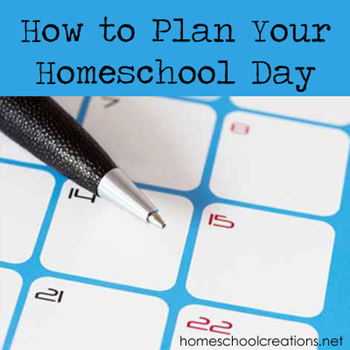

While it seems intimidating, planning your homeschool day is something that can be done. Having a schedule or routine in place can help bring organization to your homeschool day and ensures that you are getting enough educational time each day as well.
Maybe you are a family who thrives on a minute by minute plan for your day, or perhaps a more laid-back approach suits your family. Some families prefer a basic outline to their day that allows more flexibility each day. Regardless of your approach, putting together an overall plan can be a help to any family.
In some ways I really dislike the term schedule. At times, it seems very rigid and confining, and over the years our homeschool day has relaxed more in style {and so have I!}. The word that really best defines our day is routine. We don’t have set time increments to work on different subject areas, but rather an overall routine that we follow each day to help us know and complete what needs to be worked on.
Creating an Outline of the Homeschool Year
A few weeks ago, I talked about setting goals for your homeschool and knowing your purpose in homeschooling. This is really the first step in your planning, because you need to know where you want to end up before you set out on your year! Throughout your planning process it is important to know what educational goals you have in mind for your children and revisit those goals periodically to make sure you are doing what needs to be done for those goals to be met.
Curious as to how I start my planning each year? Here’s a peek at how I break down our year and get started planning in the month or two prior to school starting:
-
Pull out a blank yearly calendar {or print off a simple one from online}. You just need a simple year-at-a-glance calendar that you can plan out an overall outline of what your school year will look like: vacation times, any special days off or field trips, co-op times, and holidays. Basically, all of the times that you know need to be blocked off your overall schedule.
-
Figure out how many days or weeks of instruction you need to complete. Depending on the homeschool laws in your state, this could vary. We basically plan on 36 weeks of school or 180 days overall {and that includes our field trips and co-op days}. Our family tries to plan a six week on and one week off routine for school. There have been some years that this has worked out wonderfully – and other years that we have had to adapt based on life circumstances. Nothing is set in stone though, so it can always be tweaked and adjusted as needed.
-
Know your family’s routine. During the summer months our family takes a bit of a longer break because we travel to visit family that lives a distance away, and we also like to camp together and take longer weekends to do that. We also take a longer time period off around Christmas and plan to have birthdays off for each family member. Your family might have more activities to adjust based around sports or other travel, so consider this when planning. There are families that school year round – do what works for your family!
-
Leave a little room to breathe. I actually have a few days here and there planned in as ‘make-up’ days – or those ‘just in case something came up and we got off-track’ days. If we need to use them, we do – if not, yay!! An added break for us, or we can keep working and take a breather somewhere else. Inevitably something unexpected always comes up, so allow yourself a little extra space!
Our schedule this year looked a little something like this:
Creating a Daily Routine
Once the outline of our year was planned, I sat down with the list of subjects and curriculum that we needed to work on to generate a plan of attack. There are some subjects that we work on daily and others that only need to be worked on a few times or once a week.
First, I worked on an overall routine for our day. Around 8:30ish we finish up any household chores and I remind {repeatedly} that we are starting school at 9am. Around 9am, we all get together in the school room and then our day looks a little something like this:
-
Calendar and Bible time {as a group}
-
History {together}
-
Handwriting & snack
-
Break up to start independent work: the oldest three start working on subjects such as math, language, vocabulary, reading, typing, and other similar subjects.
-
Start 1:1 work with our youngest {math, science, reading, etc….} and when his work is finished, work with the next oldest or answer questions as needed. Finish most of work with the youngest two before lunch {a few of Zachary’s subjects spill over into the afternoon, including science, writing, and spelling}
-
Lunch & Break {about 45 minutes}
-
After lunch the oldest three work on science with me and then I work with any of the kids on subjects that need 1:1 help such as spelling, writing, etc.
-
Wrap up with any additional subjects as needed – such as art or Little Passports
Organizing Our School Paperwork
Something that I have found helpful over the last several years is this simple folder system for organizing our paperwork. I spend a few days in the weeks before school printing off all of the worksheets and papers we need for the year in the month before school starts, pulling all papers from workbooks and dividing every thing out for the year before the year starts. I wrote an entire post about Organizing Homeschool Paperwork that you can read to see how I do it {or bookmark for later}.
Using the Weekly Workbox Grid to Visually Organize Our Day
I am a very visual person and the format of the weekly workbox grid {or workfolders like we use} works very well for our family. Before the school year starts, I lay out each day of the week and pull out the different subject cards for each child along with their weekly grids. The subject cards are then organized by day so that the kids and I can both see what subjects still need to be worked on that day {and they can work ahead too if they are able too}.
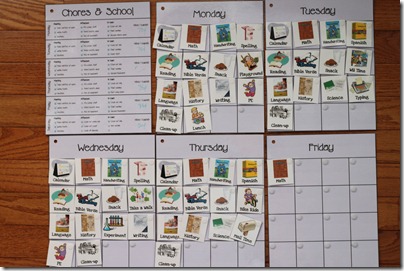
This format has also helped me when deciding what day to work on different subjects. For example, I work on spelling with the girls on one day, but Zachary’s lesson are on an opposite day. This way I can also see if we have too many ‘heavy’ subjects planned in a day and adjust accordingly.
You can read more about the Weekly Workbox Grid here.
Plugging it into My Weekly Homeschool Planner
Once I have our routine figured out and a basic plan in place, I begin plugging things into my Weekly Homeschool Planner. I actually print a copy off each year so that I can edit {without getting distracted on my laptop during the school day} and then put it into the editable pdf file each week.
The paper copy of my planner is stored in my Homeschool Binder and stays on my desk so I can keep track of our week as we go along. If you would like to see more of my Homeschool Binder, you can take a peek at it here.
Additional Tips for Planning Your Daily Routine
-
Plan for breaks. Don’t forget to give yourself and the kids periodic breaks in their day. Whether for snacks, lunch, or a quick ‘get the wiggles out’ break, it’s helpful to plan times to give yourself a mental break.
-
Know your kid’s most productive times. Our children are all early risers, so it works for us to start school earlier. Your family may not function well until afternoon. Plan your day around the times that you will be most productive overall.
-
Schedule the subjects that require more focus or tend to get put aside FIRST. When we switched our group subjects such as history and Bible to the beginning of our day, we began to accomplish SO much more. We originally would try to do them at the end of the day and they sometimes got pushed aside and lost in the shuffle. Getting them done first has helped tremendously.
-
Add fun to your day. Puzzles, manipulatives, and other hands-on activities many times get shelved – but there is so much that can be learned from them as well. Be sure to include them throughout your week. Our solution has been adding a ‘fun jar’ that has slips of paper with all of the different manipulatives and extras from the shelves. When there is a lull in the day, the kids go pick a slip and work on that project.
-
Be flexible and re-evaluate periodically. The plans can look great on paper, but when you try to implement them, you may find areas that need tweaking. Every month or two, be sure to adjust areas that need help – it’s all part of the process of finding that ‘groove’ for your family.
-
Know when to wrap it up. Granted there are times that you need to stick to your guns and have your kids complete something, but have an end time in goal for each day. There are days when you will get so wrapped up in your learning and lose track of time, but some days that clock will just tick, tick, tick… If you can set a specific ‘stop’ time for each day that the kids look forward to, it can help a lot {for them and you!}.
Overall, the planning process will take a little bit of preparation and time at the beginning, but will help SO much over the course of the year! With each year that goes by, the process goes more quickly too as we already have a basic routine in place and know more of what to expect from our days and the curriculum we are using.
Give yourself grace when planning. You won’t get it perfect – and it’s ok! And remember that schedules are great, but the best part about homeschooling is that we have this amazing time to spend with our kids and have FUN learning together – and that is the most important thing!
What planning tip would you give to other homeschool moms? Is there something that has helped you along the way? Leave a comment and share!
This post is a part of the Homeschool Basics series. Be sure to read the other posts if you are just joining in. For the record, I am not an expert. I’m a homeschool mom who is sharing what she’s learned so far along the way with her own family.


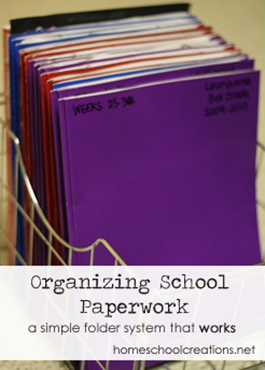
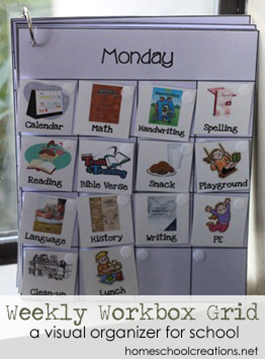
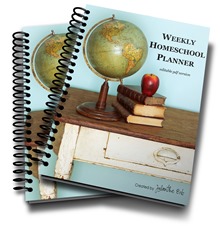


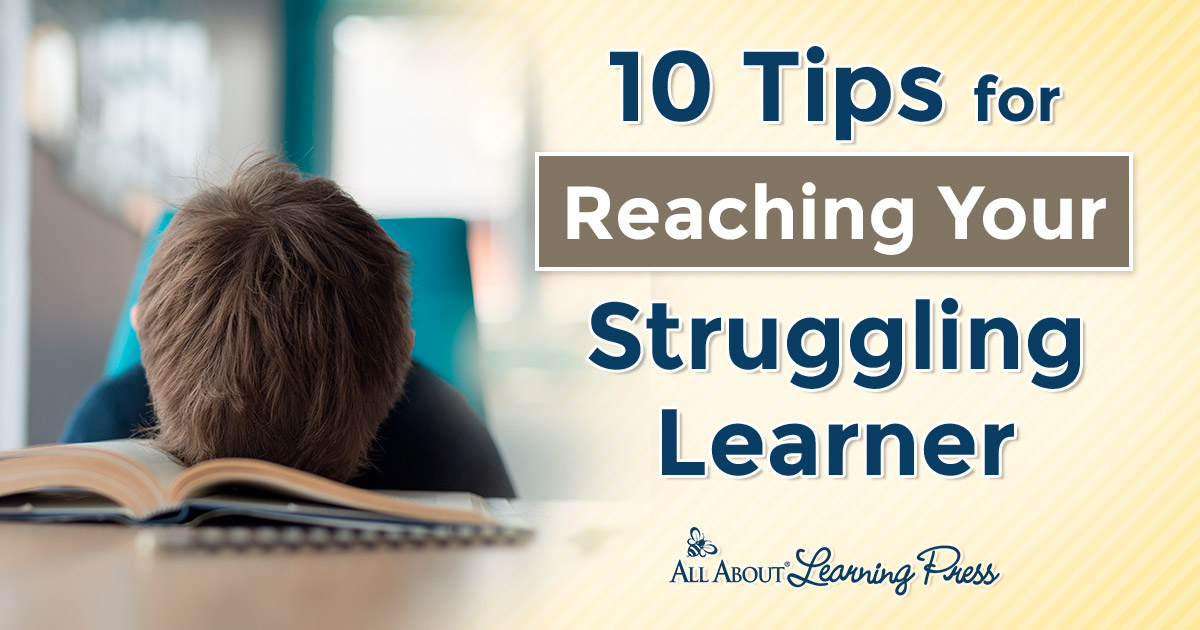




 The printables shared on this site are FREE of charge unless otherwise noted, and you are welcome to download them for your personal and/or classroom use only. However, free or purchased printables are NOT to be reproduced, hosted, sold, shared, or stored on any other website or electronic retrieval system (such as Scribd or Google docs). My printables are copyright protected and I appreciate your help in keeping them that way.
If you download and use some of my printables and then blog about them, please provide a link back to my blog and let me know - I'd love to see how you are using them! Please be sure to link to the blog post or web page and not directly to the file itself. Thank you!
The printables shared on this site are FREE of charge unless otherwise noted, and you are welcome to download them for your personal and/or classroom use only. However, free or purchased printables are NOT to be reproduced, hosted, sold, shared, or stored on any other website or electronic retrieval system (such as Scribd or Google docs). My printables are copyright protected and I appreciate your help in keeping them that way.
If you download and use some of my printables and then blog about them, please provide a link back to my blog and let me know - I'd love to see how you are using them! Please be sure to link to the blog post or web page and not directly to the file itself. Thank you!
I love your idea for a fun jar! Good advice.
Loved reading this, thank you!
I tried organizing my papers exactly like Jolanthe does my first year and it didn’t work for me. What I figured out worked better for us is having a pocket folder for each two week period, one week per side. I have 18 folders for our 36 weeks and it is all ready to go. Same concept but a slightly different execution worked great this year. I loved having it all “done” ahead of time.
Thanks for sharing, Alicia!!! :) Having it ‘done’ for me as well, helps some little part of my brain relax. :)
It may sound silly, but I’ve found it helpful to work on plans for the next year, as this year progresses. Early on in the school year, I come up with our themes for the next year, then each month, when I have extra time or feel the need to be productive, I work on the plans for each month and it’s syllabus. Our district requires that home schooling parents hand in a syllabus for the year, as well as texts we’re going to use, etc. By working on it slowly, yet at a steady pace, I find I don’t get too burned out. We have also decided to home school year round so we don’t have to spend as much time each day doing work. My kiddos can’t really handle such a long day with their special needs.
I really enjoyed your tips and suggestions!
Renae – that sounds like a fabulous idea!! {and not silly at all}
This post couldn’t have come at a better time. I feel a little overwhelmed at times on our decision to homeschool, but your information has been very helpful and inspiring. Thanks so much!
What items do you include in your fun jar?
I’m working on a post about that! :)
Thank you so much for your help and taking the time to write this Out. I’m a first time homeschool mom, my oldest is 5. I was wondering if you could give me advice on curriculum? And what is the best bible curriculum out there? I’ve heard of grapevine studies, and wondered if there are any others. Thank you!
Cher,
Here’s a post that I wrote about choosing homeschool curriculum: https://www.homeschoolcreations.net/2013/04/homeschool-basics-how-to-choose-homeschool-curriculum/
Hopefully there are some answers to your question there. As far as Bible curriculum goes, there are SO many different ones and much depends on your children. We have used Grapevine with our family and have really enjoyed it. This year, we will be using the Picture Smart Bible. There is also a company called Positive Action that has a curriculum for each grade level. Much depends on if it is something you want to do together as a family. If you oldest is 5, I would stick with something simple {and stick figures from Grapevine is a great place to start!}. :)
Jolanthe
Thank you thank you thank you! I have spent soooo many hours surfing through homeschool websites, trying to read homeschool books and stressing about the whole curriculum thing. Yours is the ONLY website that makes sense to me. Even though I am going with a few tweaks on curriculum for my own son’s needs, you’ve got every thing I need. LOVE the organizational stuff you’ve got, the tips, and the straight-to-the-point style. You are my new best friend.
Well, hello friend. :) Let me know if you have any other questions. I’d be happy to answer them for you.
I am so new to this as well and I’m so thankful to have landed on this page. I’m going to absorb it all. I will be homeschooling our 4 (17, 11, 9, 6) next year as we make an international move for a year. 3 of them will be doing online courses and my Kinder child will do something a little different, not sure what yet. So I’m trying to process in my mind how this is going to work. How long is your day? You mentioned starting at 8:30, when do you end?
Kami, It really depends on the day. We are typically finished around 1:30, but some of our days go a bit longer if we are working on an art project. Our oldest two are able to do a lot of their work independently now, so we work on all of our group subjects together so they can finish up in their own timing. :)